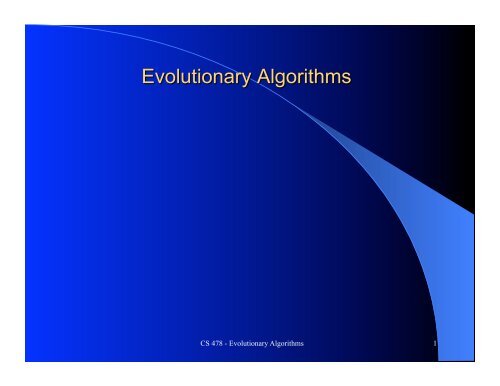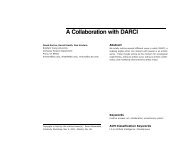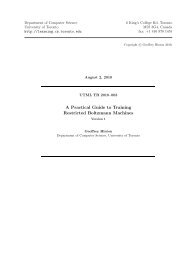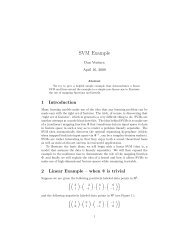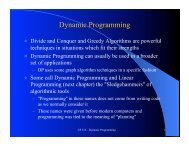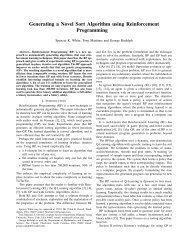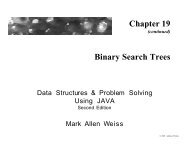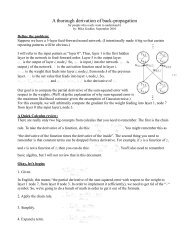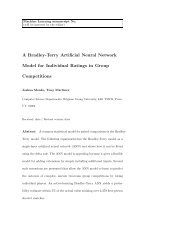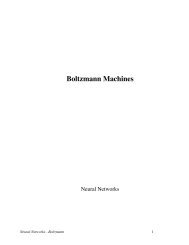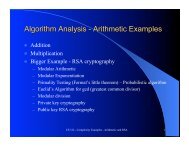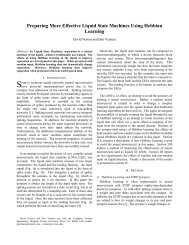CS 478 - Evolutionary Algorithms 1 - Neural Networks and Machine ...
CS 478 - Evolutionary Algorithms 1 - Neural Networks and Machine ...
CS 478 - Evolutionary Algorithms 1 - Neural Networks and Machine ...
Create successful ePaper yourself
Turn your PDF publications into a flip-book with our unique Google optimized e-Paper software.
<strong>CS</strong> <strong>478</strong> - <strong>Evolutionary</strong> <strong>Algorithms</strong> 1
Simulate “natural” evolution of structures via selection <strong>and</strong><br />
reproduction, based on performance (fitness)<br />
Type of heuristic search to optimize any set of parameters-<br />
Discovery, not inductive learning in isolation<br />
Create "genomes" which represent a current potential<br />
solution with a fitness (quality) score<br />
Values in genome represent parameters to optimize<br />
– MLP weights, TSP path, potential clusterings, etc.<br />
Discover new genomes (solutions) using genetic operators<br />
– Recombination (crossover) <strong>and</strong> mutation are most common<br />
<strong>CS</strong> <strong>478</strong> - <strong>Evolutionary</strong> <strong>Algorithms</strong> 2
Populate our search space with initial r<strong>and</strong>om solutions<br />
Use genetic operators to search the space<br />
Do local search near the possible solutions with mutation<br />
Do exploratory search with recombination (crossover)<br />
1 1 0 2 3 1 0 2 2 1 (Fitness = 60)<br />
2 2 0 1 1 3 1 1 0 0 (Fitness = 72)<br />
1 1 0 2 1 3 1 1 0 0 (Fitness = 55)<br />
2 2 0 1 3 1 0 2 2 1 (Fitness = 88)<br />
<strong>CS</strong> 312 – Approximation 3
Start with initialized population P(t) - r<strong>and</strong>om, domainknowledge,<br />
etc.<br />
Typically have fixed population size (type of beam search),<br />
large enough to maintain diversity<br />
Selection<br />
– Parent_Selection P(t) - Promising Parents more likely to be chosen<br />
based on fitness to create new children using genetic operators<br />
– Survive P(t) - Pruning of less promising c<strong>and</strong>idates, Evaluate P(t) -<br />
Calculate fitness of population members. Could be simple metrics<br />
to complex simulations.<br />
Survival of the fittest - Find <strong>and</strong> keep best while also<br />
maintaining diversity<br />
<strong>CS</strong> <strong>478</strong> - <strong>Evolutionary</strong> <strong>Algorithms</strong> 4
Procedure EA<br />
t = 0;<br />
Initialize Population P(t);<br />
Evaluate P(t);<br />
Until Done{ /*Sufficiently “good” individuals discovered or many<br />
iterations passed with no improvement, etc.*/<br />
t = t + 1;<br />
Parent_Selection P(t);<br />
Recombine P(t);<br />
Mutate P(t);<br />
Evaluate P(t);<br />
Survive P(t);}<br />
<strong>CS</strong> 312 – Approximation 5
Goal: Discover a new automotive engine to maximize<br />
performance, reliability, <strong>and</strong> mileage while minimizing<br />
emissions<br />
Features: CID (Cubic inch displacement), fuel system, # of<br />
valves, # of cylinders, presence of turbo-charging<br />
Assume - Test unit which tests possible engines <strong>and</strong><br />
returns integer measure of goodness<br />
Start with population of r<strong>and</strong>om engines<br />
<strong>CS</strong> <strong>478</strong> - <strong>Evolutionary</strong> <strong>Algorithms</strong> 6
<strong>CS</strong> <strong>478</strong> - <strong>Evolutionary</strong> <strong>Algorithms</strong> 7
<strong>CS</strong> <strong>478</strong> - <strong>Evolutionary</strong> <strong>Algorithms</strong> 8
Individuals are represented so that they can be manipulated<br />
by genetic operators<br />
Simplest representation is a bit string, where each bit or<br />
group of bits could represent state of a feature/parameter<br />
Assume the following represents a set of parameters<br />
p 1 p 2 p 3 p 4 p 5 p 6 p 7<br />
1 0 1 0 0 0 1 1 1 1 0 1<br />
Could do crossovers anywhere or just at parameter breaks<br />
Can use more complex representations including real<br />
numbers, symbolic representations (e.g. programs for<br />
genetic programming), etc.<br />
<strong>CS</strong> <strong>478</strong> - <strong>Evolutionary</strong> <strong>Algorithms</strong> 9
Crossover variations - multi-point, uniform, averaging, etc.<br />
Mutation - R<strong>and</strong>om changes in features, adaptive, different<br />
for each feature, etc.<br />
Others - many schemes mimicking natural genetics:<br />
dominance, selective mating, inversion, reordering,<br />
speciation, knowledge-based, etc.<br />
<strong>CS</strong> <strong>478</strong> - <strong>Evolutionary</strong> <strong>Algorithms</strong> 10
<strong>CS</strong> <strong>478</strong> - <strong>Evolutionary</strong> <strong>Algorithms</strong> 11
Each individual in the population should have a fitness<br />
based on the fitness function<br />
Fitness function will depend on the application<br />
– Learning system will usually use accuracy on a validation set for<br />
fitness (note that no training set needed, just validation <strong>and</strong> test)<br />
– Solution finding (path, plan, etc.) - Length or cost of solution<br />
– Program - Does it work <strong>and</strong> how efficient is it<br />
Cost of evaluating function can be an issue. When<br />
expensive can approximate or use rankings, etc. which<br />
could be easier.<br />
Stopping Criteria - A common one is when best c<strong>and</strong>idates<br />
in population are no longer improving over time<br />
<strong>CS</strong> <strong>478</strong> - <strong>Evolutionary</strong> <strong>Algorithms</strong> 12
In general want the fittest parents to be involved in<br />
creating the next generation<br />
However, also need to maintain diversity <strong>and</strong> avoid<br />
crowding so that the entire space gets explored (local<br />
minima vs global minima)<br />
Most common approach is Fitness Proportionate<br />
Selection (aka roulette wheel selection)<br />
Everyone has a chance but the fittest are more likely<br />
€<br />
Pr(h i<br />
) =<br />
Fitness(h i<br />
)<br />
| population|<br />
∑<br />
j=1<br />
Fitness(h j<br />
)<br />
<strong>CS</strong> <strong>478</strong> - <strong>Evolutionary</strong> <strong>Algorithms</strong> 13
There are other methods which lead to more diversity<br />
Rank selection<br />
– Rank order all c<strong>and</strong>idates<br />
– Do r<strong>and</strong>om selection weighted towards highest rank<br />
– Keeps actual fitness value from dominating<br />
Tournament selection<br />
– R<strong>and</strong>omly select two c<strong>and</strong>idates<br />
– The one with highest fitness is chosen with probability p, else the lesser is<br />
chosen<br />
– p is a user defined parameter, .5 < p < 1<br />
– Even more diversity<br />
Fitness scaling - Scale down fitness values during early generations.<br />
Scale back up with time. Equivalently could scale selection<br />
probability function over time.<br />
<strong>CS</strong> <strong>478</strong> - <strong>Evolutionary</strong> <strong>Algorithms</strong> 14
Population size - Larger gives more diversity but with diminishing<br />
gain, small sizes of ~100 are common<br />
How many new offspring will be created at each generation (what %<br />
of current generation will not survive)<br />
<br />
<br />
– Keep selecting parents without replacement until quota filled<br />
New c<strong>and</strong>idates replace old c<strong>and</strong>idates to maintain the population<br />
constant<br />
Many variations<br />
– R<strong>and</strong>omly keep best c<strong>and</strong>idates weighted by fitness<br />
– No old c<strong>and</strong>idates kept<br />
– Always keep a fixed percentage of old vs new c<strong>and</strong>idates<br />
– Could keep highest c<strong>and</strong>idate seen so far in a special memory since it may<br />
be deleted during normal evolution<br />
<strong>CS</strong> <strong>478</strong> - <strong>Evolutionary</strong> <strong>Algorithms</strong> 15
<strong>CS</strong> <strong>478</strong> - <strong>Evolutionary</strong> <strong>Algorithms</strong> 16
There exist mathematical proofs that evolutionary techniques are<br />
efficient search strategies<br />
There are a number of different <strong>Evolutionary</strong> algorithm approaches<br />
– Genetic <strong>Algorithms</strong><br />
– <strong>Evolutionary</strong> Programming<br />
– Evolution Strategies<br />
– Genetic Programming<br />
Strategies differ in representations, selection, operators, evaluation,<br />
survival, etc.<br />
Some independently discovered, initially function optimization<br />
(EP, ES)<br />
Strategies continue to “evolve”<br />
<strong>CS</strong> <strong>478</strong> - <strong>Evolutionary</strong> <strong>Algorithms</strong> 17
Representation based typically on a list of discrete tokens,<br />
often bits (Genome) - can be extended to graphs, lists, realvalued<br />
vectors, etc.<br />
Select m parents probabilistically based on fitness<br />
Create m (or 2m) new children using genetic operators<br />
(emphasis on crossover) <strong>and</strong> assign them a fitness - singlepoint,<br />
multi-point, <strong>and</strong> uniform crossover<br />
Replace m weakest c<strong>and</strong>idates in the population with the<br />
new children (or can always delete parents)<br />
<strong>CS</strong> <strong>478</strong> - <strong>Evolutionary</strong> <strong>Algorithms</strong> 18
Representation that best fits problem domain<br />
All n parents mutated (no crossover) to create n new<br />
children - total of 2n c<strong>and</strong>idates<br />
Only n most fit c<strong>and</strong>idates are kept<br />
Mutation schemes fit representation, varies for each<br />
variable, amount of mutation (typically higher probability<br />
for smaller mutation), <strong>and</strong> can be adaptive (i.e. can<br />
decrease amount of mutation for c<strong>and</strong>idates with higher<br />
fitness <strong>and</strong> based on time - form of simulated annealing)<br />
<strong>CS</strong> <strong>478</strong> - <strong>Evolutionary</strong> <strong>Algorithms</strong> 19
Similar to <strong>Evolutionary</strong> Programming - initially used for<br />
optimization of complex real systems - fluid dynamics, etc.<br />
- usually real vectors<br />
Uses both crossover <strong>and</strong> mutation. Crossover first. Also<br />
averaging crossover (real values), <strong>and</strong> multi-parent.<br />
R<strong>and</strong>omly selects set of parents <strong>and</strong> modifies them to<br />
create > n children<br />
Two survival schemes<br />
– Keep best n of combined parents <strong>and</strong> children<br />
– Keep best n of only children<br />
<strong>CS</strong> <strong>478</strong> - <strong>Evolutionary</strong> <strong>Algorithms</strong> 20
Evolves more complex structures - programs, Lisp<br />
code, neural networks<br />
Start with r<strong>and</strong>om programs of functions <strong>and</strong> terminals<br />
(data structures)<br />
Execute programs <strong>and</strong> give each a fitness measure<br />
Use crossover to create new programs, no mutation<br />
Keep best programs<br />
For example, place lisp code in a tree structure,<br />
functions at internal nodes, terminals at leaves, <strong>and</strong> do<br />
crossover at sub-trees - always legal in Lisp<br />
<strong>CS</strong> <strong>478</strong> - <strong>Evolutionary</strong> <strong>Algorithms</strong> 21
<strong>CS</strong> <strong>478</strong> - <strong>Evolutionary</strong> <strong>Algorithms</strong> 22
Use a Genetic Algorithm to learn the weights of an MLP.<br />
Used to be a lab.<br />
<strong>CS</strong> <strong>478</strong> - <strong>Evolutionary</strong> <strong>Algorithms</strong> 23
Use a Genetic Algorithm to learn the weights of an MLP.<br />
Used to be a lab.<br />
You could represent each weight with m (e.g. 10) bits<br />
(Binary or Gray encoding), remember the bias weights<br />
Could also represent <strong>Neural</strong> Network Weights as real<br />
values - In this case use Gaussian style mutation<br />
Walk through an example comparing both representations<br />
<strong>CS</strong> <strong>478</strong> - <strong>Evolutionary</strong> <strong>Algorithms</strong> 24
Much current work <strong>and</strong> extensions<br />
Numerous application attempts. Can plug into many algorithms requiring<br />
search. Has built-in heuristic. Could augment with domain heuristics.<br />
If no better way, can always try evolutionary algorithms, with pretty good<br />
results ("Lazy man’s solution" to any problem)<br />
Many different options <strong>and</strong> combinations of approaches, parameters, etc.<br />
Swarm Intelligence – Particle Swarm Optimization, Ant colonies,<br />
Artificial bees, Robot flocking, etc.<br />
More work needed regarding adaptivity of<br />
– population size<br />
– selection mechanisms<br />
– operators<br />
– representation<br />
<strong>CS</strong> <strong>478</strong> - <strong>Evolutionary</strong> <strong>Algorithms</strong> 25
Reinforcement Learning - sparse payoff<br />
Contains rules which can be executed <strong>and</strong> given a fitness (Credit<br />
Assignment) - Booker uses bucket brigade scheme<br />
GA used to discover improved rules<br />
Classifier made up of input side (conjunction of features allowing don’t<br />
cares), <strong>and</strong> an output message (includes internal state message <strong>and</strong><br />
output information)<br />
Simple representation aids in more flexible adaptation schemes<br />
<strong>CS</strong> <strong>478</strong> - <strong>Evolutionary</strong> <strong>Algorithms</strong> 26
Each classifier has an associated strength. When matched<br />
the strength is used to competitively bid to be able to put<br />
message on list during next time step. Highest bidders put<br />
messages.<br />
Keeps a message list with values from both input <strong>and</strong><br />
previously matched rules - matched rules set outputs <strong>and</strong><br />
put messages on list - allows internal chaining of rules - all<br />
messages changed each time step.<br />
Output message conflict resolved through competition (i.e.<br />
strengths of classifiers proposing a particular output are<br />
summed, highest used)<br />
<strong>CS</strong> <strong>478</strong> - <strong>Evolutionary</strong> <strong>Algorithms</strong> 27
Each classifier bids for use at time t. Bid used as a<br />
probability (non-linear) of being a winner - assures<br />
lower bids get some chances<br />
B(C,t) = bR(C)s(C,t)<br />
where b is a constant
s(C,t+1) = s(C,t) -B(C,t) - Loss of Strength for each consumer (price<br />
paid to be used, prediction of how good it will pay off)<br />
{C'} = {suppliers} - Each of the suppliers shares an equal portion of<br />
strength increase proportional to the amount of the Bid of each of the<br />
consumers in the next time step<br />
s(C',t+1) = s(C',t) + B(C i ,t)/|C'|<br />
You pay suppliers amount of bid, receive bid amounts from consumers.<br />
If consumers profitable (higher bids than you bid) your strength<br />
increases. Final rules in chain receive actual payoffs <strong>and</strong> these<br />
eventually propagate iteratively. Consistently winning rules give good<br />
payoffs which increases strength of rule chain, while low payoffs do<br />
opposite.<br />
<strong>CS</strong> <strong>478</strong> - <strong>Evolutionary</strong> <strong>Algorithms</strong> 29


